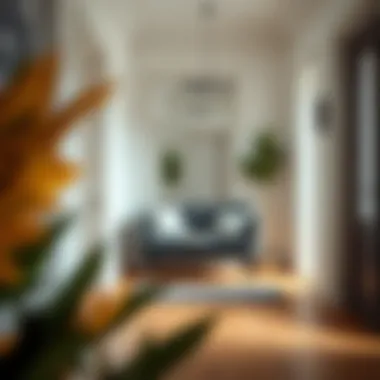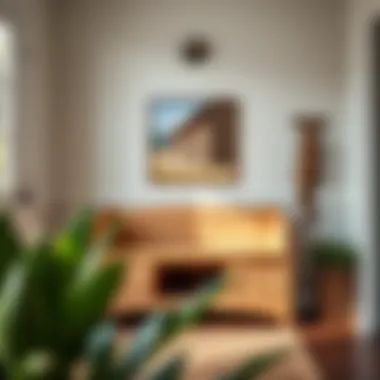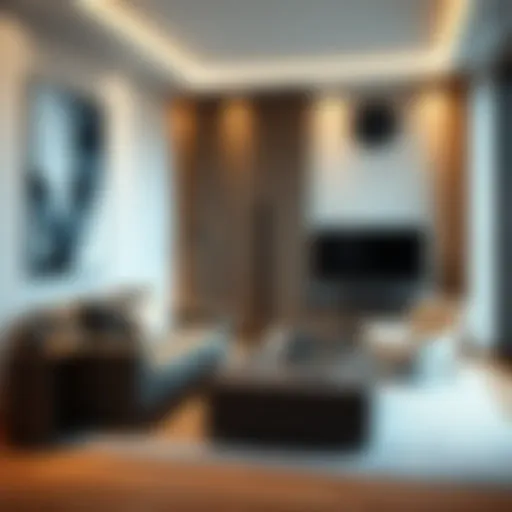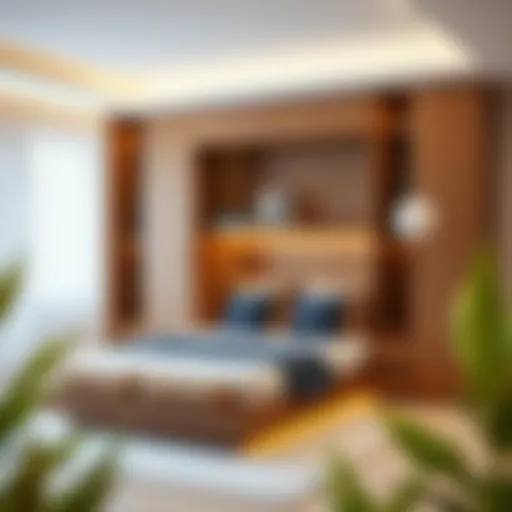Exploring the Multifunctionality of Door Entrance Benches


Intro
In the world of interior design, the entrance to a home speaks volumes. It is a threshold that welcomes guests and sets the tone for what lies beyond. One often overlooked yet entirely functional piece of furniture that plays a significant role in this space is the door entrance bench. Far more than a mere piece of wood, a well-chosen bench serves multiple purposes: it provides a spot to sit while putting on or taking off shoes, offers a convenient storage solution for hats and scarves, and enhances the overall aesthetics of the entryway.
As homeowners and design enthusiasts seek to elevate the functionality and visual appeal of their spaces, door entrance benches have become increasingly versatile. This article will unpack the varied design trends, practical considerations, and aesthetic importance of these benches, giving insight into how they can transform an otherwise uninspired area into something remarkable.
Design Trends
Current Trends in Furniture Styles
In today’s market, door entrance benches are available in myriad designs that cater to a range of tastes and preferences. From rustic farmhouse styles to sleek, contemporary aesthetics, the options seem endless. Current trends lean towards minimalist forms where functionality meets simplicity. The Scandinavian design approach, characterized by clean lines and functionalities, is particularly popular. It embodies an ethos of practicality and space-saving that resonates with modern homeowners.
On the other end of the spectrum, bohemian or eclectic styles invite creative expression. These benches often feature vibrant colors, intricate patterns, or artisan craftsmanship, serving as a statement piece rather than just functional furniture.
How to Incorporate Trends into Your Space
When looking to incorporate these trends into your own entryway, consider the following:
- Assess Your Space: Take a close look at the area where the bench will reside. Does it have enough width to accommodate a larger piece? Is it better suited for a sleek option? Knowing your spacing helps narrow down choices.
- Choose Functional Features: Consider benches that provide storage solutions, whether through drawers, baskets, or shelves. This can aid in clutter management and enhance the overall organization of your entry.
- Contrast or Complement: Decide whether your bench will harmonize with existing decor or stand out as a focal point. A bold color can make a statement in an otherwise neutral area, while a soft palette can create a calming effect.
Buying Guides
Choosing the Right Furniture for Different Rooms
Selecting a door entrance bench involves several factors that can influence not just its aesthetic but also its utility. When deciding on the right piece:
- Material Matters: Hardwood benches might lend durability, while metal provides a modern flair. Consider how the material complements your entryway and the general theme of your home.
- Style and Functionality: Different designs serve various purposes. A padded bench invites comfort while a wooden slat construction might offer a more traditional feel. Assess your needs and incorporate accordingly.
Tips for Assessing Quality and Value
An investment in a door entrance bench is an investment in your home’s comfort and style. To ensure you’re making a sound choice:
- Inspect the Build: Look for sturdy construction and attention to detail in finishing. A wobbly bench isn’t just an aesthetic issue; it compromises safety.
- Understand Materials: Choose materials that can withstand wear and tear while being easy to maintain. Solid woods like oak or walnut, while sometimes pricier, offer longevity.
- Compare Pricing: As with any furniture purchase, shop around. Compare different brands and styles to get a feel for what is available at varying price points. Researching offers can lead to valuable savings.
A well-thought-out entrance bench not only adds to the decor but can also serve as a central hub for organization in your entryway.
In exploring the multifaceted roles that door entrance benches can play, we see that they are far more than mere seats. They can be central pieces in creating an inviting atmosphere in the home. By understanding current design trends and knowing what to look for in a purchase, anyone can find the perfect bench that balances utility and beauty.
Understanding the Concept of Door Entrance Benches
Door entrance benches play a significant role in modern homes, evolving from a mere utility to a fundamental aspect of interior design. As the first piece of furniture one encounters upon entering a dwelling, these benches set the tone for not only the interior décor but also the welcome a visitor receives. The importance of understanding door entrance benches lies in their multi-faceted utility, their ability to enhance aesthetic appeal, and the array of styles they offer that can complement various interiors.
Definition and Purpose
Definitions might vary slightly from person to person, but at its core, a door entrance bench is an adaptable piece of furniture positioned just inside the front door or entrance area. Its purpose crosses several lines: it provides a place to sit while putting on or removing footwear, serves storage needs for shoes or accessories, and acts as a decorative element that can elevate the overall look of the entryway.
Moreover, these benches often include features like hooks for coats, compartments for storing bags, or even small shelves for decorative items, creating a functional focal point right at the threshold of one’s home. The choice of a well-crafted door entrance bench can not only organize clutter but also create an inviting atmosphere that reflects the homeowner’s style.
Historical Context
To comprehend the significance of door entrance benches today, it helps to look back at their journey through history. Originating in ancient homes, benches were simple structures; often used for sitting and resting. As time progressed, the purpose evolved, particularly during the Victorian era, where aesthetics became just as important as functionality. Victorians favored ornate designs that showcased craftsmanship, introducing elements like upholstered seating and intricate carvings for visual appeal.
As home living changed and design trends shifted, the 20th century brought forth a wave of minimalism, leading to simpler, more utilitarian designs that focus on functionality without over-decoration. However, in the present day, we see a blend of historical influences, where vintage charm meets modern practicality. The entrance bench has reclaimed its status as an essential element that embodies both utility and design, bridging the gap between past and present.
"A well-designed entrance bench is not just a piece of furniture; it's the first impression of a home, merging utility with style."
Thus, the concept of door entrance benches transcends simple categorization. It weaves together threads of history, practicality, and design ethos. Understanding this concept helps homeowners, designers, retailers, and DIY enthusiasts appreciate the value that such benches contribute to their entryway spaces in an evolving home environment.


Functional Benefits of Door Entrance Benches
Door entrance benches serve beyond mere decoration. They are practical solutions that contribute significantly to organizing and enhancing the functionality of an entryway. These pieces are particularly valuable in homes where space may be at a premium or where a welcoming ambiance is desired. With their utility, style, and functionality intertwined, door entrance benches truly become multi-purpose elements in any home’s design schema.
Storage Solutions
Types of Storage
Door entrance benches often come equipped with storage options, catering to the varied needs of everyday life. This storage can take many forms: underneath seating, within hidden compartments, or as additional shelving. Each design equates function with style, ensuring that storage doesn’t appear as an afterthought. A bench with a lift-top can hide shoes, umbrellas, or seasonal items from view while also being readily accessible. This dual purpose not only maximizes functionality but also maintains an organized look in the hallway, which is essential for welcoming guests.
The key characteristic of these storage types is their ability to blend in with the overall aesthetics of the space. Whether it’s a chic fabric upholstered bench that adds splash or a robust wood design lending a rustic appeal, their storage facilities remain inconspicuous yet highly efficient.
However, potential downsides exist. Some designs may compromise space if they are too bulky or not tailored to fit the area appropriately, causing clutter instead of alleviating it. Careful consideration of dimensions and needs must guide choices in type and structure.
Maximizing Space
The importance of maximizing space cannot be overstated, especially in smaller homes or apartments. Door entrance benches can transform underutilized areas into practical spots for everyday needs. A slim bench can be squeezed into a narrow corridor, providing not just seating but also essential storage.
The hallmark of good design in this aspect is versatility. A bench that serves as both a seat and a small console for decor can eliminate the need for extra furniture pieces, effectively decluttering. This approach not only streamlines space but can enhance the aesthetic appeal as well.
However, one should tread carefully; cramming too much into a tight area can lead to a chaotic feel. Balance and proportion are crucial when considering how a bench will affect the space around it.
Seating Arrangements
Convenience of Seating
A bench at the door can be a welcome respite for family and friends alike as they enter your home. It offers an immediate place to rest bags or to put on shoes, making the transition from outdoors to indoors super smooth. This convenience cannot be underestimated, especially when you have children or visitors.
The unique feature here is that it establishes a brief pause, a moment within the door frame before fully entering the home. This moment can be pivotal in setting the tone for a cozy and inviting space.-
Look at the placement of the seating – an appropriately sized bench placed thoughtfully can reduce the hustle of a busy entryway. However, seating arrangements must always consider traffic patterns. A bench blocking the flow can lead to more headaches than help.
Social Interaction at the Entrance
Door entrance benches also cater to social interactions, serving as a friendly spot for quick chats or farewells. Imagine where a visitor can take a moment to sit and remove their shoes or simply converse with you as they linger before leaving. It creates a sense of approachability and warmth that is often missing in cold, stark entryways.
The key here is the concept of connection. An inviting entrance encourages social engagement, thus making an entrance bench not just furniture but a foundation for relationships.
However, it’s essential to avoid overcrowding the bench area with too much decor or other items that may clutter the space. Overstuffed entryways can kill the invitation to sit and interact, rendering the space less functional in its social capacity.
In summary, the functional benefits of door entrance benches go beyond mere aesthetics; they enhance organization, offer comfort, and promote social interaction. Properly designed and placed, entrance benches can create a more harmonious and user-friendly environment for all who enter.
Design Variations in Door Entrance Benches
When exploring the world of door entrance benches, one must appreciate the diverse design variations that elevate them from mere functional pieces to statements of style. Design variations are crucial because they allow homeowners to select options that not only fit their practical needs but also harmonize with the overall aesthetic of their living spaces. Different materials and styles give life to the entryway, creating a welcoming first impression for visitors while accommodating everyday family use. In this section, we will delve into the materials employed in these benches and explore trending styles that capture individuality and functionality.
Materials Used
Wood
Wood is often the first material that comes to mind when considering door entrance benches, and for good reason. Its inherent warmth and natural beauty can transform any entryway into a cozy haven. One key characteristic of wood is its versatility; it can easily take on various finishes, from rustic to polished, allowing it to adapt seamlessly to surrounding decor.
The unique feature of wooden benches lies in their potential for customization. Homeowners can choose different types of wood, such as oak, teak, or pine, which each carry their unique textures and colors. This choice can enhance not only the aesthetic appeal but also the longevity of the bench.
However, wood does have its drawbacks. It may require regular maintenance like polishing or sealing to prevent wear and tear from moisture or constant use. Despite this, its warm appearance and ability to blend with different decor styles make wood a hugely popular choice.
Metal
Metal benches are often viewed as a statement piece in modern entryways, adding an industrial flair that can be both striking and utilitarian. A key characteristic of metal is its strength and durability, making it well-suited for high-traffic areas. These benches often come in various finishes, such as brushed steel or wrought iron, allowing them to harmonize with both contemporary and traditional settings.


What makes metal a unique choice is its ability to support creative designs. From sleek lines that emphasize minimalism to ornate details that bring a touch of elegance, metal benches can meet diverse aesthetic needs.
However, metal can be prone to scratching and fingerprints, which may require frequent cleaning. The coldness of metal might also not appeal to everyone who seeks the warmth of wood. Yet, when paired with soft cushions or colorful accents, metal benches can become a stylish focal point in any entrance.
Fabric Upholstery
Fabric upholstered benches bring a different kind of comfort and softness to the entryway. This material excels in creating a cozy, inviting vibe, perfect for homes with a more casual or eclectic style. A key characteristic of fabric is its wide variety of design choices, ranging from bold patterns to subtle textures, enhancing the overall visual experience.
One distinctive advantage of fabric upholstery is the comfort it offers. Users can sink into a plush cushion after a long day or during a moment of contemplation before leaving home. Additionally, upholstery is often available in stain-resistant and durable fabrics, which can withstand the wear and tear of daily life.
However, fabric upholstered benches require more upkeep than wood or metal. They can absorb spills, dust, and dirt, necessitating regular cleaning and maintenance. Despite these challenges, their appeal lies in their ability to personalize the space with color and texture, making them a favored choice for many.
Style Trends
Modern
The modern style is often characterized by clean lines, minimalistic shapes, and a lack of excessive ornamentation, making it a sought-after option for contemporary entryways. Modern benches often prioritize functionality without compromising beauty, creating a seamless entry experience. These benches can elevate the overall design of the space and serve as practical seating solutions.
One distinct advantage of modern design is its adaptability. Unlike traditional styles that may feel out of date, modern features can easily incorporate the latest trends and innovations in home decor. However, the downside can be a sterility in presentation if not balanced with warmth or personal touches.
Rustic
Rustic style brings a sense of earthiness and charm to door entrance benches, often using natural materials and distressed finishes. It embodies a nostalgic appeal, evoking images of cozy retreats in country cottages or cabins. The unique feature of rustic benches is their ability to tell a story through the wood grains or metal textures used.
Such benches often have a character that comes from imperfections, making them feel warm and inviting. However, the ruggedness and lack of refinement might not fit well in more sophisticated settings. Still, the charm that rustic pieces bring is undeniable and can create a warm welcome in any home.
Minimalist
The minimalist design philosophy embraces simplicity and the "less is more" approach. This style often incorporates neutral colors, clean lines, and an emphasis on function. Minimalist benches can contribute to a clutter-free environment, promoting a sense of calm in the often busy entryway.
One unique feature of minimalist benches is their potential to blend perfectly with diverse interior styles, allowing for a cohesive flow throughout the home. However, the lack of embellishments might be perceived as too austere for some who prefer a more vibrant or eclectic style.
Choosing the Right Door Entrance Bench
Selecting the appropriate door entrance bench is not merely a matter of aesthetics; it requires thoughtful consideration of several key elements that intertwine design, utility, and overall harmony within a space. An entrance bench serves as more than a place to sit; it can effectively enhance organization and set the tone of the home right at the doorstep. Homeowners and designers alike must take care to ensure that the chosen piece aligns seamlessly with both functional needs and the surrounding decor.
Assessing Space and Dimensions
Before finalizing the decision on a door entrance bench, assessing the available space is crucial. This isn't just about choosing a bench that fits; it's about creating a welcoming and functional entryway. To start off, measuring the area where the bench will reside helps to dictate the possible size options.
- Height Considerations: The ideal bench height typically ranges between 18-20 inches for comfortable seating. It should accommodate a average adult without causing discomfort.
- Width and Length: Consider how much space you can allocate for the bench. Will it be a narrow option against a wall, or will it be more spacious for family usage? Aim for a width that provides room for movement but doesn't obstruct foot traffic.
- Proximity to Other Elements: Evaluate how the bench interacts with other furniture or architectural features such as doors and stairways. A clutter-free entrance allows for easy transitions between indoor and outdoor spaces.
Taking these elements into account ensures that your bench serves its purpose effectively while enhancing the overall flow of your entryway.
Matching with Interior Decor
Once you have a grasp on the spatial dimensions, the next step is to ensure the bench complements the existing decor. This matching doesn’t just hinge on color schemes or style, but also creates a coherent visual narrative throughout the home.
- Color Harmony: Select colors that resonate with your interior palette. Soft earth tones may communicate warmth, while vibrant hues can add a lively element to a muted space.
- Style Consistency: If the decor leans towards the minimalist, a sleek bench with clean lines works beautifully. For a rustic feel, reclaimed wood finishes or vintage designs could provide that unique charm.
- Material Choices: Different materials can evoke different sentiments. For instance, metal can add an industrial flair, while fabric upholstery brings softness to the space.
The right bench is an opportunity to make a strong first impression, wrapping utility and design into a single statement piece.
Creating a harmonious environment ensures that the bench not only serves its purpose but also resonates with the overall aesthetic of the home. When these considerations are thoughtfully addressed, the door entrance bench becomes a focal point that enriches the space, rather than just a functional item.
The Role of Door Entrance Benches in Enhancing Aesthetics
Door entrance benches serve not just a functional purpose but also play a pivotal role in aesthetic enhancement. The way a space looks and feels can deeply influence first impressions, and the entrance area is often the first line of communication between a home and the outside world. By thoughtfully incorporating an entrance bench, one can create an inviting entryway that echoes personal style while also being practical. The visual aspect of these benches can tie together various design elements and contribute to a home’s overall personality.


In addition to providing a place to sit while removing shoes or bags, these benches can bring a sense of elegance, balance, and cohesion to the overall layout of an entryway. They are often central pieces in the home’s entrance, guiding the eye and setting the tone for the rest of the decor.
Visual Balance
Creating visual balance in an entryway is key to establishing harmony and flow. An entrance can easily seem cluttered or chaotic, especially in smaller spaces. A well-chosen door entrance bench can act as an anchor, bringing equilibrium to the area.
Here’s how it works:
- Contrast and Complement: A bench can introduce contrasting textures—like a sleek metal with a woven fabric or natural wood with polished stone. This can create interest without overwhelming the senses.
- Scale Matters: The size of the bench should be proportionate to the entrance. A bench that’s too large may dwarf other features, while a small bench might get lost in a vast space. Finding the right dimensions fosters a sense of balance.
- Color Coordination: Utilizing a bench that harmonizes with the entrance’s color scheme can seamlessly integrate it into the space, contributing to a cohesive appearance.
When these elements are considered, the door entrance bench transforms from mere furniture to a thoughtfully curated piece that enhances visual appeal.
Creating Focal Points
A focal point captures attention and directs the gaze, making it an essential aspect of design. In a well-designed entryway, the door entrance bench can function as this focal piece, drawing the eye and setting a welcoming tone.
Tips for maximizing the focal potential of your bench:
- Accessorizing Wisely: Adding cushions, throws, or decorative trays can enhance the bench while adding layers to the design. These accessories can be swapped with the seasons, refreshing the look of the entrance without major alterations.
- Lighting Consideration: Proper lighting can elevate the aesthetic of any furniture piece. Installing a stylish wall sconce or placing a small lamp on or near the bench can spotlight it, making it pop in the overall scheme of the entryway.
- Art Integration: Using artwork or mirrors above the bench can tie the space together. A mirror not only enlarges the space visually but also reflects light, adding depth and style to your entrance.
"An entryway is not merely a passage; it’s the introduction to your home’s soul."
Ultimately, the beauty of door entrance benches lies in their multifaceted role as both utility tools and style enhancers, making them invaluable in any home.
Practical Tips for Maintenance and Care
Taking care of door entrance benches is not just about prolonging their life; it’s also about enhancing the overall aesthetic and utility of your entryway. The entrance area of a home is often the first impression guests receive, so ensuring that your bench looks appealing and functions well is essential. A few basic maintenance practices can help keep your door entrance bench in tip-top shape. Here’s a look at some key aspects of maintenance and care that can be easily integrated into your routine.
Cleaning Guidelines
Regular cleaning is crucial for maintaining the allure of your door entrance bench. Dust and debris can accumulate quickly, especially in high-traffic areas. Here are some useful cleaning tips:
- Dust Regularly: Use a microfiber cloth at least once a week to wipe down the surface of the bench. This helps to pick up fine particles without scratching the finish.
- Spot Clean Stains: For fabric upholstered benches, use a fabric cleaner or a mild soap solution to tackle spills promptly. Blot the stain instead of rubbing to avoid spreading it.
- Wood Care: If your bench is made of wood, consider applying a suitable wood polish or oil every few months. This not only cleans but also enriches the wood’s color and protects against wear.
- Vacuum Cushions: If your bench has cushions, give them a good vacuum every now and then. This helps to eliminate dust mites and keeps them looking fresher.
With just a bit of regular attention, your door entrance bench can stand the test of time and maintain its visual appeal.
Dealing with Wear and Tear
Every entrance bench will face wear and tear, but proactive care can minimize its effects:
- Inspect Regularly: Keep an eye out for any loose hinges or screws, especially in benches with storage compartments. Tightening them promptly can prevent further damage.
- Protective Pads: If your bench is placed on a hard surface, consider using felt pads on the legs. This can prevent scratching and make it easier to move the bench without causing damage to your flooring.
- Reupholster When Needed: If the fabric shows signs of significant wear, reupholstering may be a wise investment. Look for bold patterns or colors that can breathe new life into the bench.
- Seasonal Deep Clean: Taking the time for a thorough clean at the change of seasons can help address built-up grime. This might include stripping down fabric covers and laundering them if they are removable.
By maintaining your door entrance benches properly, you'll not only extend their longevity but also significantly improve the first impressions they make.
Incorporating these practical maintenance tips into your care routine can make all the difference in keeping your entrance bench looking sharp and functioning well. Ultimately, a well-maintained bench contributes not only to organization but also to the overall atmosphere of your home.
Closure: The Enduring Appeal of Door Entrance Benches
Door entrance benches have carved out a significant niche in modern interiors, melding aesthetic charm with functional practicality. In this article, we've unraveled the unique dimensions that make these benches more than just a means to sit and change shoes. They not only provide a convenient spot for some quick adjustments before stepping outside but also create a warm, inviting first impression for anyone entering your home.
Summarizing Key Takeaways
It’s clear that these benches serve multiple roles in entryway design:
- Utility: They are essential for storing items like shoes, umbrellas, and bags, helping to declutter spaces.
- Comfort: Offering a place to sit while putting on or taking off shoes, they elevate the overall user experience.
- Aesthetic Impact: These benches act as focal points in the entry area, enhancing the overall decor and contributing to the room's flow and harmony.
Moreover, the variety in styles, materials, and designs—ranging from rustic wooden structures to sleek modern designs—ensures that there is always something to fit every taste. Homeowners and designers can select options that harmonize with the rest of the decor, while also serving specific functions tailored to the household's needs.
Future Trends in Entrance Design
As we look to the future, a few trends stand out regarding door entrance benches:
- Sustainable Materials: More designers prioritize eco-friendly options, utilizing reclaimed wood or recycled materials to create benches that are as sustainable as they are stylish.
- Multifunctional Designs: The push for adaptability in home furnishings will likely lead to benches that incorporate smart storage solutions, with hidden compartments and modular designs.
- Innovative Styles: Expect to see a blend of styles come to the forefront. Design elements from vintage to ultra-modern will merge, creating unique pieces that can cater to varied aesthetic preferences.
In essence, door entrance benches will continue to evolve, further embedding themselves into the fabric of home design. Their lasting appeal lies in their ability to adapt, combining style with unmatched practicality—an essential piece for any entryway.















